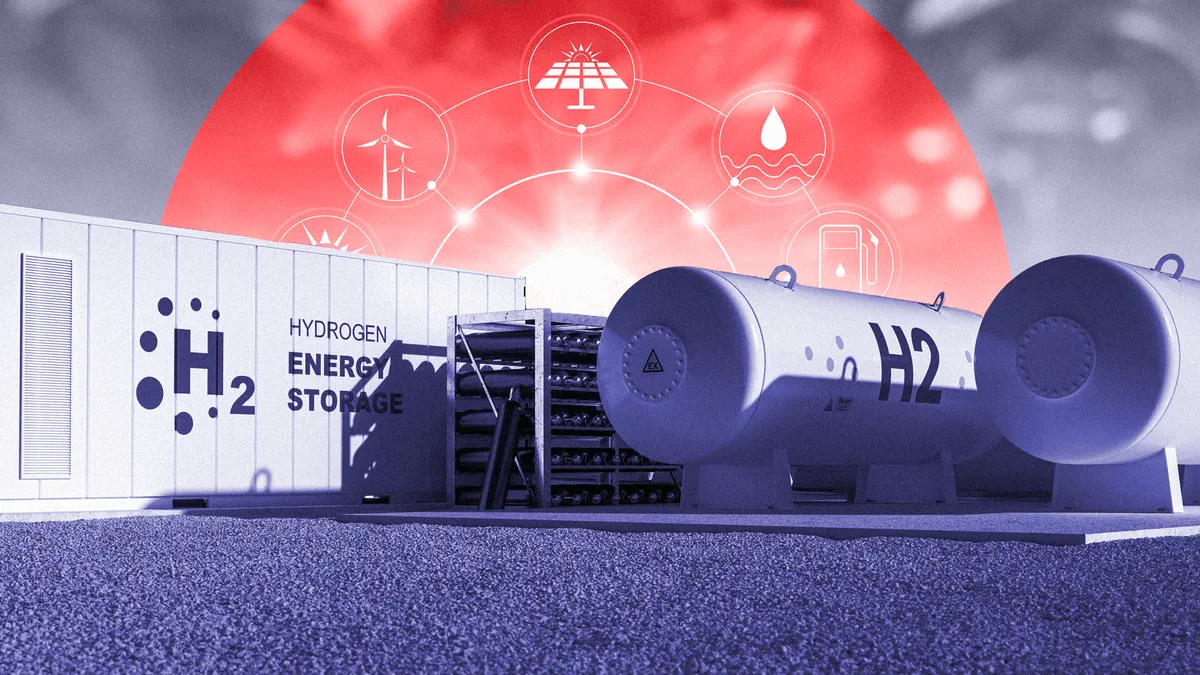Dive Brief:
-
Decarbonized hydrogen could help reduce global emissions, but costs must come down to $1 per kilogram to compete with other energy resources, researchers from Resources for the Future, a nonprofit research institute, said during a Tuesday webinar.
-
Hydrogen procured from fossil fuels and paired with carbon capture could cost $1.25 per kilogram as soon as 2030, according to the group, while green hydrogen — produced using electrolysis powered by renewable energy — is projected to near the $1 mark by 2050.
-
Splitting hydrogen from natural gas, if paired with carbon capture, is currently equal to today's social cost of carbon value, according to Resources for the Future Senior Research Fellow Jay Bartlett. But in the absence of political support for a carbon tax, he said implementing tax credits for decarbonized hydrogen production could help to accelerate the development of the industry in the United States.
Dive Insight:
Whether or not hydrogen becomes a mainstream fuel for power generation, Bartlett said, decarbonizing hydrogen for existing industrial uses, such as fertilizer, could have a worthwhile social benefit. It's also quite feasible, he said.
Today the world's hydrogen comes primarily from fossil fuels — mostly from using steam to split hydrogen from natural gas in the U.S. — and this hydrogen production accounts for 2% of global carbon emissions, according to Bartlett. Simply switching to electrolysis driven by power from the U.S. grid would actually increase emissions due to conversion losses, he said, but lower-carbon solutions are potentially on the horizon.
The technology to decarbonize hydrogen exists, but the high cost of producing carbon-free hydrogen remains a barrier, Bartlett said, with the cost of renewable energy and of the electrolysis itself representing the most critical inputs. Despite that, he said, producing green hydrogen with wind and solar energy alone could compete with conventional hydrogen derived from fossil fuels by 2050. Adding carbon capture to the existing methane reforming process to create “blue” hydrogen could compete by 2030.
“The current cost of blue hydrogen with partial [carbon] capture is just about equal to today's social cost of carbon, so we're almost to the point that it's socially beneficial to use blue hydrogen,” Bartlett said. “And if we get to the projections for green hydrogen, that will become even more beneficial.”
Linda Dempsey, vice president of public affairs for ammonia producer CF Industries, said that the production of cost-effective clean hydrogen in the U.S. “is critical to bring forward environmental jobs and benefits,” and to achieving the company's own 2050 decarbonization goal. However, she noted that the U.S. is lagging with respect to clean hydrogen investment.
“We see hydrogen investment in the EU, Asia, and even Australia and New Zealand outpacing North America,” Dempsey said, a trend she attributed to the presence of government policies that have created a sense of stability for the hydrogen industry in those regions.
Dempsey also said that if the U.S. does not take action to keep pace, the U.S. could lose the jobs and economic benefits associated with clean hydrogen production to other nations.
Alan Krupnick, also a senior research fellow for Resources for the Future, said that their policy analysis had arrived at production tax credits, modeled after those already available for wind, solar or carbon capture, as the most promising option for spurring greater investment in clean hydrogen in the U.S..
“There are two options, for the basis of the tax credit,” he said. “One is CO2 emissions that are actually reduced in the project you apply for, and the other is the amount of decarbonized hydrogen you produce. Jay and I favor CO2 reduction, because that's what you're really trying to produce.”
The size of the tax credit, Krupnick said, could be based on the social cost of carbon, which would make blue hydrogen cost competitive, or could start higher and then gradually decrease over a period of ten years or more.
“On top of this, you need monitoring and verification programs so everyone feels that society is benefiting from this and there's no fraud,” he said.
Krupnick said they had also evaluated a series of other possible pathways on hydrogen policy, but ruled them out as less likely or less effective. A carbon tax, for example, would be effective but did not seem politically feasible even under the Biden administration, Krupnick said. A clean energy standard does seem promising, he said, but whether it would benefit hydrogen specifically is unclear.
And while the government itself could require the use of decarbonized hydrogen in its own steel, cement and chemical purchases to get the market rolling, Krupnick said that would likely be too costly to the government.














